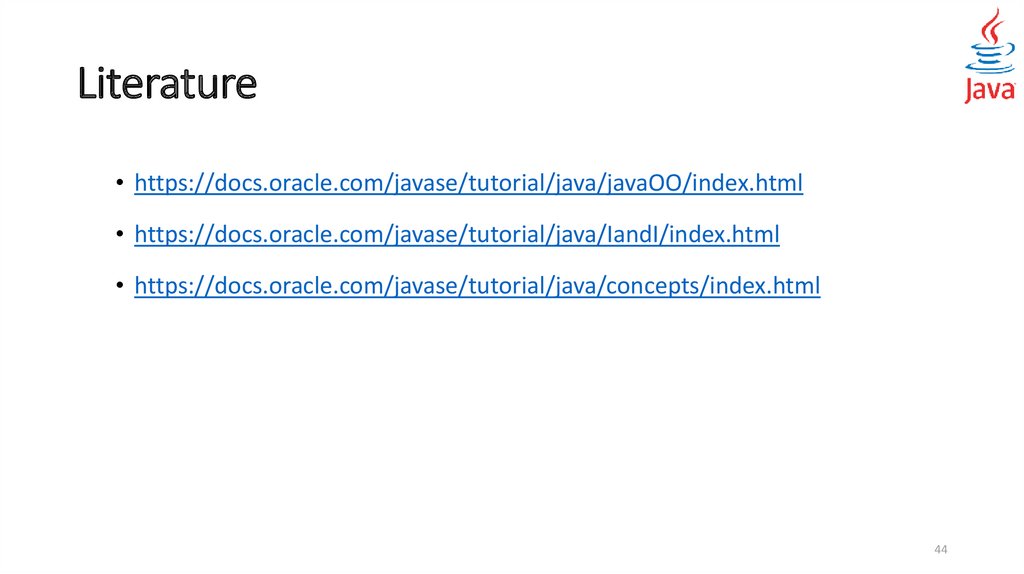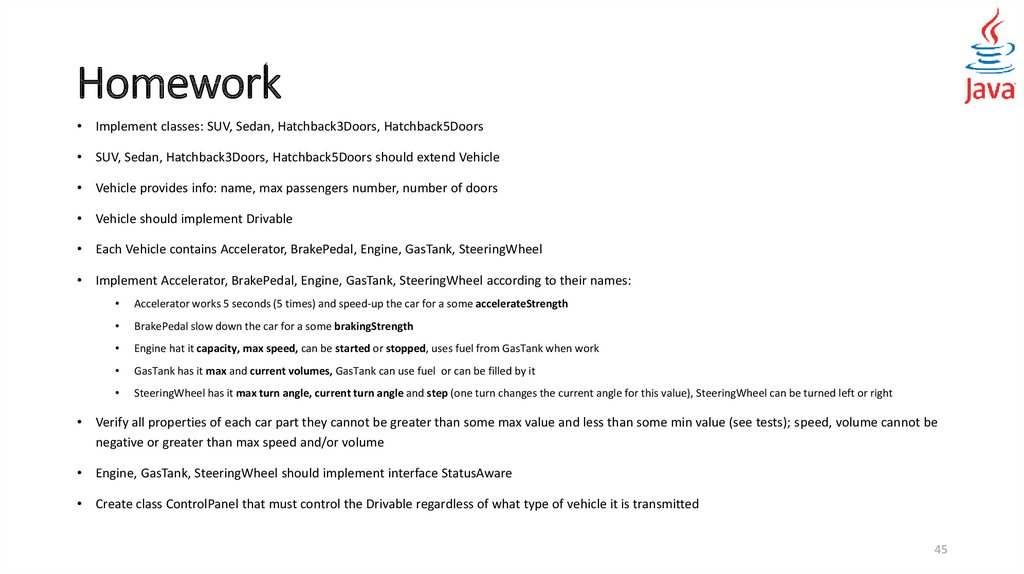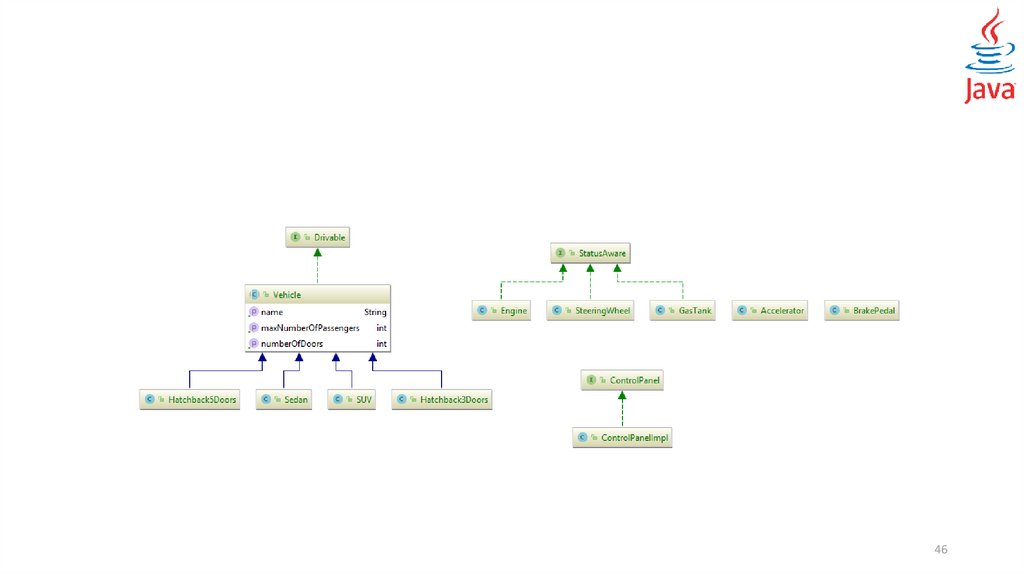Similar presentations:
Java 4 WEB. Lesson 3 - OOP
1. Java 4 WEB
Lesson 3 - OOP1
2. Lesson goals
• Class design• Implement encapsulation
• Implement inheritance including visibility modifiers and composition
• Implement polymorphism
2
3. Object vs Class
34. Abstract Classes
• May contain any number of methods including zero• If class has at least one abstract method – class is abstract
• abstract void clean()
• Abstract methods may not appear in a class that is not abstract
• The first concrete subclass of an abstract class is required to implement all
abstract methods that were not implemented by a superclass
4
5. Method vs Constructor
Method describes behaviorMethod signature:
- name
- arguments (including order)
Specific method with the same to class name and without return statement
called Constructor
5
6. Constructor
class Monkey extends Animal {int paws;
class Animal {
String name;
public Monkey() {
super(); // not necessary
}
Animal() {
this("No-Name");
}
Monkey(int paws) {
super("Bandar-log");
paws = paws;
// BAD
this.paws = paws;
}
public Animal(String name) {
this.name = name;
}
}
class Main{
public static void main(String[] args) {
println(new Monkey());
println(new Monkey(2));
}
}
public void Monkey() {
// this(3);
// BAD
}
public void Monkey(int i) {
System.out.println(“OMG”);
}
}
6
7. Overloading and Overriding
class Game {void play() {
// move to the left
}
}
class Mario extends Game {
@Override
public void play() { // overriding
// move to the left, move to the right
}
void play(Character character) { // overloading
// omg, I’m chicken
}
int play() { // will not compile
// lol
}
}
7
8. Overriding rules
• The access modifier must be the same or more accessible;• The return type must be the same or a more restrictive type, also known as covariant
return types;
• If any checked exceptions are thrown, only the same exceptions or subclasses of those
exceptions are allowed to be thrown;
• The methods must not be static. (If they are, the method is hidden and not overridden);
• @Override - It is a great idea to get in the habit of using it in order to avoid accidentally
overloading a method.
8
9. Overloading precedence
• Exact match by type• Matching a superclass type
• Converting to a larger primitive type
• Converting to an autoboxed type
• Varargs
9
10. Overloading precedence
class Overloading {static void overloadedMethod(int i) { // will enter if nothing is commented
System.out.println("in int");
}
static void overloadedMethod(long i) { // will enter if comment 'int'
System.out.println("in long");
}
static void overloadedMethod(Integer i) { // will enter if comment 'int' and 'long'
System.out.println("in Integer");
}
static void overloadedMethod(Number i) { // will enter if comment 'int', 'long' and 'Integer'
System.out.println("in Number");
}
static void overloadedMethod(int... i) { // will enter if comment 'int', 'long', 'Integer' and 'Number'
System.out.println("in var arg");
}
public static void main(String[] args) {
overloadedMethod(10);
}
}
10
11. Interface
• Defines a set of public abstract methods, which classes implementing the interfacemust provide.
• Allows you to define what a class can do without saying how to do it (interface is a
contract)
• A class may implement multiple interfaces as well as extend classes that implement
interfaces, allowing for limited multiple inheritance in Java
• May extend other interfaces, although they may not extend a class and vice versa
• May contain public static final constant values, public and private methods, public
default methods.
11
12. Interface
interface Walk {int someConst = 1;
public static final int anotherConst = 1;
boolean isQuadruped();
private void doSomething() {
//do some work
}
class Lion implements Run {
public boolean isQuadruped() {
return true;
}
}
public boolean canHuntWhileRunning() {
return true;
}
interface Run extends Walk {
public abstract boolean canHuntWhileRunning();
public double getMaxSpeed() {
return 100;
}
abstract double getMaxSpeed();
default double getMaxSpeed(){
return 1;
}
}
}
12
13. Interface
Provides a way for one individual to develop code that uses anotherindividual’s code, without having access to the other individual’s
underlying implementation. Interfaces can facilitate rapid application
development by enabling development teams to create applications in
parallel, rather than being directly dependent on each other (for
example one team uses interface, another team implements it)
13
14. Functional interface
@FunctionalInterfaceinterface Speakable {
String say();
static void someStatic(){}
default void someDefault(){}
private void doSomething(){}
}
14
15. Nested Classes
Types of nested classes:• A member inner class is a class defined at the same level as instance variables. It is not
static. Often, this is just referred to as an inner class without explicitly saying the type.
• A local inner class is defined within a method.
• An anonymous inner class is a special case of a local inner class that does not have a
name.
• A static nested class is a static class that is defined at the same level as static variables.
15
16. Nested Classes
• encapsulate helper classes by restricting them to thecontaining class
• make it easy to create a class that will be used in only one
place
• can make the code easier to read.
16
17. Member Inner Classes
public static void main(String[] args) {A a = new A();
A.B b = a.new B();
class A {
A.B.C c = b.new C();
private int x = 1;
c.printAll();
class B {
}
private int x = 2;
class C {
private int x = 3;
public void printAll() {
System.out.println(x); // 3
System.out.println(this.x); // 3
System.out.println(B.this.x); // 2
System.out.println(A.this.x); // 1
}
}
}
}
17
18. Local Inner Classes
public static void main(String[] args) {Outer outer = new Outer();
outer.calculate();
}
class Outer {
private int length = 5;
public void calculate() {
final int width = 20;
class Inner {
public void multiply() {
System.out.println(length * width);
}
}
Inner inner = new Inner();
inner.multiply();
}
}
18
19. Anonymous Inner Classes
public static void main(String[] args) throws Exception {JButton button = new JButton("red");
button.addActionListener(new ActionListener() {
public void actionPerformed(ActionEvent e) {
// handle the button click
}
});
}
19
20. Static Nested Classes
class Enclosing {static class Nested {
private int price = 6;
}
public static void main(String[] args) {
Nested nested = new Nested();
System.out.println(nested.price);
}
}
20
21. Enum
• A special data type that enables for a variable to be a set of predefinedconstants
• Has unique set of values
• Can implement interface
• Can NOT extend class
• Can contain fields and methods
• Singleton
21
22. Enum
enum Planet implements IGravitable {MERCURY (3.303e+23, 2.4397e6) {
@Override
double surfaceGravity() {
return -1;
}
},
VENUS
(4.869e+24, 6.0518e6),
EARTH
(5.976e+24, 6.37814e6)
//
...
;
private double mass;
final double radius;
// in kilograms
// in meters
Planet(double mass, double radius) {// private
this.mass = mass;
this.radius = radius;
}
// universal gravitational constant (m3 kg-1 s-2)
public static final double G = 6.67300E-11;
@Override
double surfaceGravity() {
return G * mass / (radius * radius);
}
}
static void main(String[] args) {
double mass = Planet.EARTH.surfaceGravity();
for (Planet p : Planet.values()){
System.out.println("Your weight on %s is %f%n", p,
p.surfaceWeight(mass));
}
System.out.println("Is Earth inhabited: " +
isPlanetInhabited(Planet.EARTH));;
}
static boolean isPlanetInhabited(Planet alivePlanet) {
switch (alivePlanet){
case EARTH:
return true;
case VENUS:
case MERCURY:
default:
return false;
}
}
22
23. Design principle
• A design principle is an established idea or bestpractice that facilitates the software design process.
23
24. Design principle
• More logical code• Code that is easier to understand
• Classes that are easier to reuse in other relationships and applications
• Code that is easier to maintain and that adapts more readily to
changes in the application requirements
24
25. OOP principles
• Class• Object
• Inheritance
• Encapsulation
• Polymorphism
25
26. OOP principles
Everything is objectObject is a class instance
Program – a set of interacting objects
Object has a state and behavior
26
27. Access modifiers
public class Dog {public String name = "Scooby-doo";
protected boolean hasFur = true;
boolean hasPaws = true;
private int id;
}
27
28. Encapsulation
2829. Encapsulation
2930. Encapsulation
• No actor other than the class itself should have direct access to itsdata. The class is said to encapsulate the data it contains and prevent
anyone from directly accessing it.
With encapsulation, a class is able to maintain certain invariants
about its internal data. An invariant is a property or truth that is
maintained even after the data is modified.
30
31. Encasulation example
class CoffeeMachine {private int sugar;
private double milk;
Coffee makeCoffee(){
blendBeans();
heatWater();
shakeMilk();
return mix();
}
private Coffee mix() {
return new Coffee(); // mix all together
}
public static void main(String[] args) {
CoffeeMachine cm = new CoffeeMachine();
Coffee coffee = cm.makeCoffee();
}
private void shakeMilk() {
// shaking milk
}
private void heatWater() {
// heating water
}
private void blendBeans() {
// blending beans
}
}
31
32. Encapsulation. Java Beans
A JavaBean is a design principle for encapsulating data in an object inJava.
• private properties
• public getter(get, is for primitive boolean)
• public setter (set)
• property name in getter/setter starts with uppercase
32
33. Encapsulation. Java Beans
public boolean isPlaying() {return playing;
}
What is wrong
class Girl {
private boolean playing;
private Boolean dancing;
public String name;
…
}
public boolean getPlaying() {
return playing;
}
public Boolean isDancing() {
return dancing;
}
public String name() {
return name;
}
public void updateName(String n) {
name = n;
}
public void setname(String n) {
name = n;
}
33
34. Encapsulation. Java Beans
public boolean isPlaying() {return playing;
}
What is wrong
class Girl {
private boolean playing;
private Boolean dancing;
public String name;
…
}
// OK
public boolean getPlaying() { // OK
return playing;
}
public Boolean isDancing() {
return dancing;
}
// BAD, get for wrapper
public String name() {
return name;
}
// BAD, not get prefix
public void updateName(String n) { // BAD, no set prefix
name = n;
}
public void setname(String n) {// BAD, wrong case
name = n;
}
34
35. Polymorphism
An object in Java may take on a variety of forms, in part depending on thereference used to access the object.
One name, many forms. Polymorphism manifests itself by having multiple
methods all with the same name, but slightly different functionality.
There are 2 basic types of polymorphism.
• Overriding, also called run-time (dynamic) polymorphism.
• Overloading, which is referred to as compile-time (static) polymorphism.
35
36. Polymorphism
The type of the object determines which properties exist withinthe object in memory.
The type of the reference to the object determines which
methods and variables are accessible to the Java program
36
37. Polymorphism
Polymorphism is the ability of a single interface to support multiple underlying forms.interface LivesInOcean {
void makeSound();
}
class Dolphin implements LivesInOcean {
public void makeSound() {
System.out.println("whistle");
}
}
class Whale implements LivesInOcean {
public void makeSound() {
System.out.println("sing");
}
}
class Oceanographer {
void checkSound(LivesInOcean animal) {
animal.makeSound();
}
void main(String[] args) {
Oceanographer o = new Oceanographer();
o.checkSound(new Dolphin());
o.checkSound(new Whale());
}
}
37
38. Polymorphism
Polymorphism also allows one object to take on many different forms.class Primate {
public boolean hasHair() {
return true;
}
}
public static void main(String[] args) {
Lemur lemur = new Lemur();
println(lemur.age);
HasTail hasTail = lemur;
println(hasTail.isTailStriped());
interface HasTail {
boolean isTailStriped();
}
class Lemur extends Primate implements HasTail {
public int age = 10;
Primate primate = lemur;
println(primate.hasHair());
}
public boolean isTailStriped() {
return false;
}
}
38
39. Inheritance (is-a)
3940. Inheritance (is-a)
class Cow extends Animal {@Override
public void feed() {
}
abstract class Animal {
String name;
@Override
public String toString() {
return name;
}
abstract void feed();
public void run(){
}
}
class Bird extends Animal {
@Override
public void feed() {
}
}
public void fly(){
}
}
40
41. Virtual methods invocation
class Cow extends Animal {public void feed() {
addHay();
}
private void addHay() {
}
}
abstract class Animal {
public abstract void feed();
}
public void feedAnimal(Animal animal) {
animal.feed();
}
class Bird extends Animal {
public void feed() {
addSeed();
}
private void addSeed() {
}
}
class Lion extends Animal {
public void feed() {
addMeat();
}
private void addMeat() {
}
}
41
42. Composition (has-a)
Object composition is the idea of creating a class by connecting otherclasses as members using the has‐a principle.
Inheritance is the idea of creating a class that inherits all of its reusable
methods and objects from a parent class.
Both are used to create complex data models, each with its own
advantages and disadvantages
42
43. Composition (has-a)
class Person {Job job;
class Job {
private long salary;
public void setSalary(long salary) {
this.salary = salary;
}
public Person() {
this.job = new Job();
job.setSalary(1000L);
}
public long getSalary() {
return job.getSalary();
}
public long getSalary() {
return salary;
}
}
}
43
44. Literature
• https://docs.oracle.com/javase/tutorial/java/javaOO/index.html• https://docs.oracle.com/javase/tutorial/java/IandI/index.html
• https://docs.oracle.com/javase/tutorial/java/concepts/index.html
44
45. Homework
Implement classes: SUV, Sedan, Hatchback3Doors, Hatchback5Doors
SUV, Sedan, Hatchback3Doors, Hatchback5Doors should extend Vehicle
Vehicle provides info: name, max passengers number, number of doors
Vehicle should implement Drivable
Each Vehicle contains Accelerator, BrakePedal, Engine, GasTank, SteeringWheel
Implement Accelerator, BrakePedal, Engine, GasTank, SteeringWheel according to their names:
Accelerator works 5 seconds (5 times) and speed-up the car for a some accelerateStrength
BrakePedal slow down the car for a some brakingStrength
Engine hat it capacity, max speed, can be started or stopped, uses fuel from GasTank when work
GasTank has it max and current volumes, GasTank can use fuel or can be filled by it
SteeringWheel has it max turn angle, current turn angle and step (one turn changes the current angle for this value), SteeringWheel can be turned left or right
Verify all properties of each car part they cannot be greater than some max value and less than some min value (see tests); speed, volume cannot be
negative or greater than max speed and/or volume
Engine, GasTank, SteeringWheel should implement interface StatusAware
Create class ControlPanel that must control the Drivable regardless of what type of vehicle it is transmitted
45














































 programming
programming








